Antony Cummins Cannot Teach Real Samurai Skills
Part 3 of my FAQ
By Paul 'Batman' O'Brien
B.A., N.C.E.H.S., Dip. Acu., Adv. Dip. OBB, Cert Clin. Med. Pn1, PN-SSR, PN-NCA, M.AFPA, M.ETCMA, M.C.Th.A.
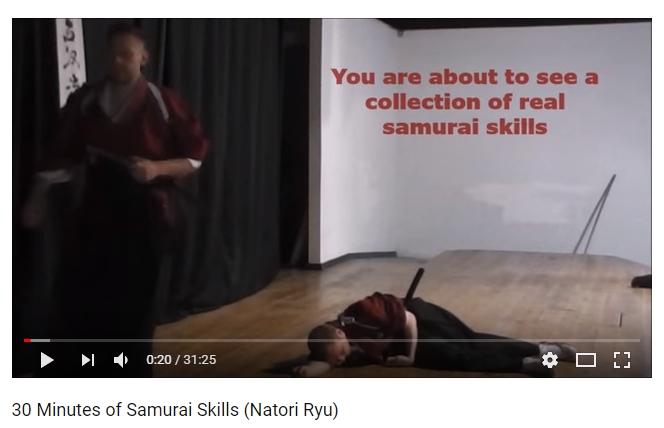 A "Natori Ryu" video on Youtube compiling several lessons Antony Cummins teaches on the samurai. Source: YouTube
A "Natori Ryu" video on Youtube compiling several lessons Antony Cummins teaches on the samurai. Source: YouTube"So throughout my life I've trained and trained in martial arts, I trained between the ages obviously as a young kid all the way up to about 30-31, and then I started to peel away and become more academic and I became less focused on martial arts".
- Antony Cummins "Katana V Pig (TEST CUT)" - 14:10
Antony Cummins cannot teach "Real Samurai Skills". This is why.
Antony Cummins is not a licensed instructor in any school of Koryu Bujutsu (the authentic historical martial arts of Japan), has had no formal training or rank at time of writing, yet, for some years now he has claimed to teach"Real Samurai Skills". He organises a yearly training event (viewable in full on YouTube), in addition to apparently regular classes and certainly has appeared to teach martial arts to school children and younger members of other dojo's.
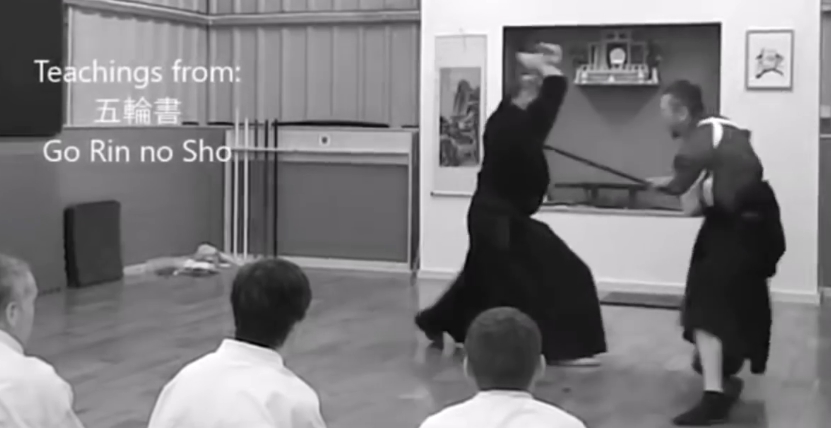 Image of Cummins teaching techniques from the Go Rin no Sho. Source: YouTube
Image of Cummins teaching techniques from the Go Rin no Sho. Source: YouTubeAntony teaches with an air of authority displayed in his many YouTube videos, where his poor techniques and worse understanding is clearly evident. This air of superior truth is utterly unjustified (again, there's that Oxford English Dictionary definition of fraud from Part 1) because Antony Cummins is not a qualified martial artist - he has zero, and I mean precisely that, nadda, nothing, zip, zilch, no qualifications from any legitimate school of koryu bujutsu and yet he claims to teach "real samurai skills".
In the previous article, "Antony Cummins is a FRAUD", I have shown you that Cummins is not a legitimate samurai historian, that he is in fact a fraud claiming academic authority he has no right to for the purpose of his personal financial gain, and further in, "Antony Cummins is Dangerous", that he is dangerous - encouraging others to place themselves in positions of great physical harm, by teaching his made up versions of techniques he reads in books.
In this article, I will focus on Cummins "teaching the techniques" of "real samurai martial arts" and I will show you conclusively why the man is utterly unqualified to do so, and that what he claims to be "real samurai skills" are nothing of the kind.
Antony Cummins Makes Things Up
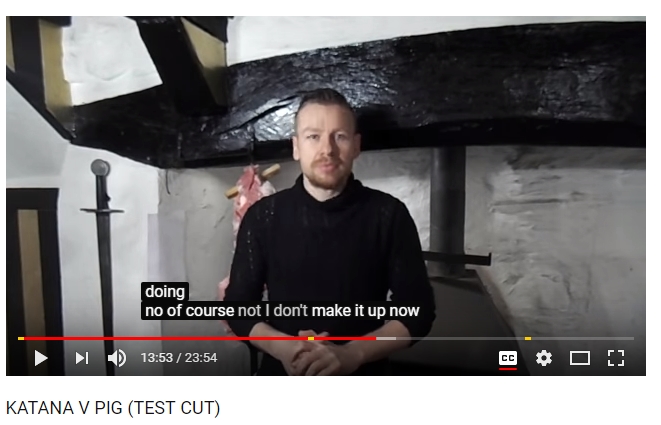 Source: YouTube
Source: YouTube"Do I make up what I am doing? No, of course not, I don't make it up".
- Antony Cummins, "Katana v Pig (TEST CUT) Video - 13:47
This is a lie.
Because this is, in fact, by definition, exactly what he does.
To “Make something up”, is defined as:
- compensate for something lost, missed, or deficient and
- invent a story, lie
(https://en.oxforddictionaries.com/definition/make_something_up)
In this article I'll show you that this is precisely what Cummins is doing. Cummins is knowingly, deliberately, inventing techniques that he has made up; ignoring the written instructions that are inconvenient or contradict the fantasy he has imagined from those same texts, ignoring the corrections, admonishments and reubkes of the koryu community and imparting his dangerous, nonsensical, samurai delusions to the public, passing them off as authentic and real, for the purposes of financial gain.
Very briefly, what Cummins does is read passages of old texts which loosely and deliberately ambiguously describe certain martial arts techniques (see Part 1 under Damasare for more on this). The information he is working from is deliberately deficient in detail and missing key steps. Then Cummins teaches his "interpretation" of them.
He literally makes something up to fill in the blanks and to satisfy what he thinks and what he feels it should be. Not based on fact, experience, or instruction. Just how he feels and what he thinks would be cool. Again, I reiterate, he has no formal qualification or teaching licence in koryu bujutsu of any kind, from which he could make an educated guess.
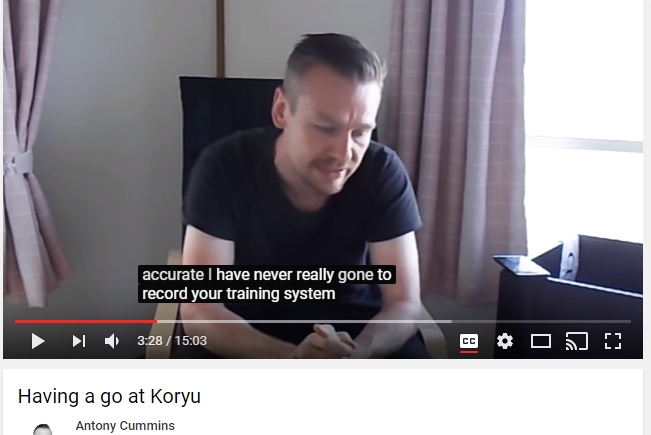 Source: YouTube
Source: YouTube"That is accurate; I have never really gone through a Koryu training system"
- Antony Cummins, "Having a go at Koryu" - 3:25
He has little to no experience in fact of koryu bujutsu. He has no skills, qualification or relevant experience on which to base his interpretation of these techniques. So how does he arrive at these interpretations? He invents them...
He makes them up.
In the previous instalment in this series I showed images from a video in which Antony encouraged his students to slice in an uncontrolled, unstable motion with the cutting edge facing the arteries and soft tissue of the body - this is one of three draws of Natori-Ryu according to Cummins. This remarkably dangerous and poor display is clear evidence of his lack of understanding of the martial arts - however, one could argue that no one knows for sure what that technique would have looked like, as the style is not taught anymore.
Cummins Does Not Even Perform the Most Basic Research
Another example of Cummins erroneous, misinformed and uneducated opinion and theory is evidenced in a video titled "How to Draw a Samurai Sword by Yamamoto Kansuke". In this Cummins "recreates" a sword drawing technique from "The School of Certain Victory", as briefly described in the work of Yamamoto Kansuke ("Secrets of the Japanese Art of Warfare; From the School of Certain Victory", trans. Cleary, Thomas; Tuttle Publishing 2012). Cummins reads a passage from the book (pg. 49) and proceeds to demonstrate his interpretation of that technique. In an earlier edit of the video he cuts himself doing so.
In this video he demonstrates pulling the sword to the right, so the sword is now perpendicular to the body (exposing his arm to be cut, and providing his opponent with excellent leverage to prevent the draw and pin him). He draws the sword (using poor form - no thumb or index finger control of the sword, incorrect use of the koiguchi (opening of the saya) which increases the risk of self injury, insufficient and incorrect grip of the saya etc) to the right (exposing himself to attack) and circles back around to Chudan no kamae, a middle posture, of holding the sword.
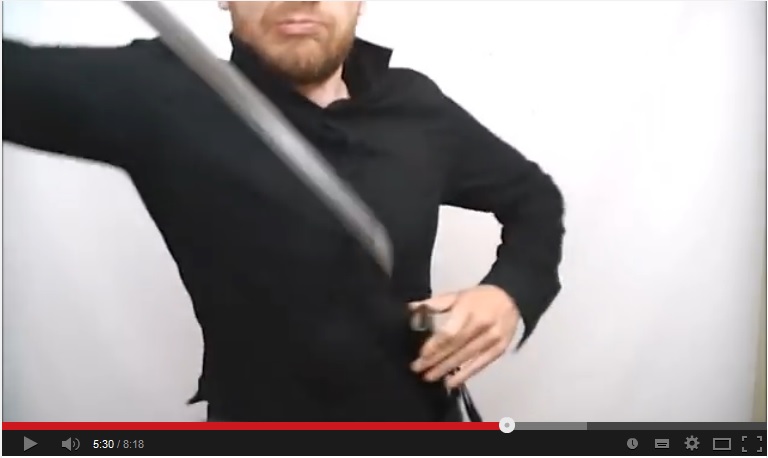 Source: YouTube
Source: YouTubeNow, the clunky, awkward movement can be forgiven. He has little experience of Japanese martial arts as noted and thus does not have the correct body mechanics and neuro-physical organisation to move fluidly.
What should not be forgiven is that the technique as he demonstrates it makes NO sense. There are a number of problems that a beginner in Iai or any koryu school over 6 months would quickly indentify:
- The number of suki (openings) he offers his opponent. Initially his right wrist, then the opportunity to lock him and the sword very easily, the odd angle of the draw exposes his body and head to the cutting edge of the blade etc
- Taking the tsuka-kashira (pommel) so wide to the right, removes any seme (pressure) being applied to the opponent and provides them opening.
- Bringing the sword widely out, simply to bring it back in is slow, inefficient and time wasting.
- Achieves nothing. Why draw to out to the right, quickly, sacrificing centre control, position and posture, to waste time circling back in to a chudan (middle) posture? Why no thrust? Why no cut? Why rush to take out a sword in such an elaborate and convoluted way only to do....nothing?
So where does Cummins go wrong? Well for a "historical researcher" he's done no research, instead simply imagining and making up how the technique must be. And having no basis in the koryu bujutsu he has neither the tactical understanding nor the neuro-physical coordination necessary to make an informed guess. Further he fails to provide the context for that movement, which may give him clue.
The technique in question is discussed in the section of the text not dealing with Iai or Kenjutsu but a section dealing with wrestling. In fact, had he looked up slightly, he would have seen in the top right hand corner, the word "wrestling". And had he looked at the index, he would have seen this technique listed under the section on wrestling and not in the section dealing with Swordsmanship.
This completely changes the dynamic and intent of the movement. Had he done his research he would have found that there are several koryu bujutsu schools that teach a method similar to that described in Kansuke's text. We have one in Musō Jikiden Eishin ryū. There's also a version in Musō Shinden ryū, Hasegawa Eishin ryū and several others.
Here's how it looks in the Musō Shinden ryū. (EXAMPLE - Musō Shinden Ryū - Daishôzume 5th kata Munedori)
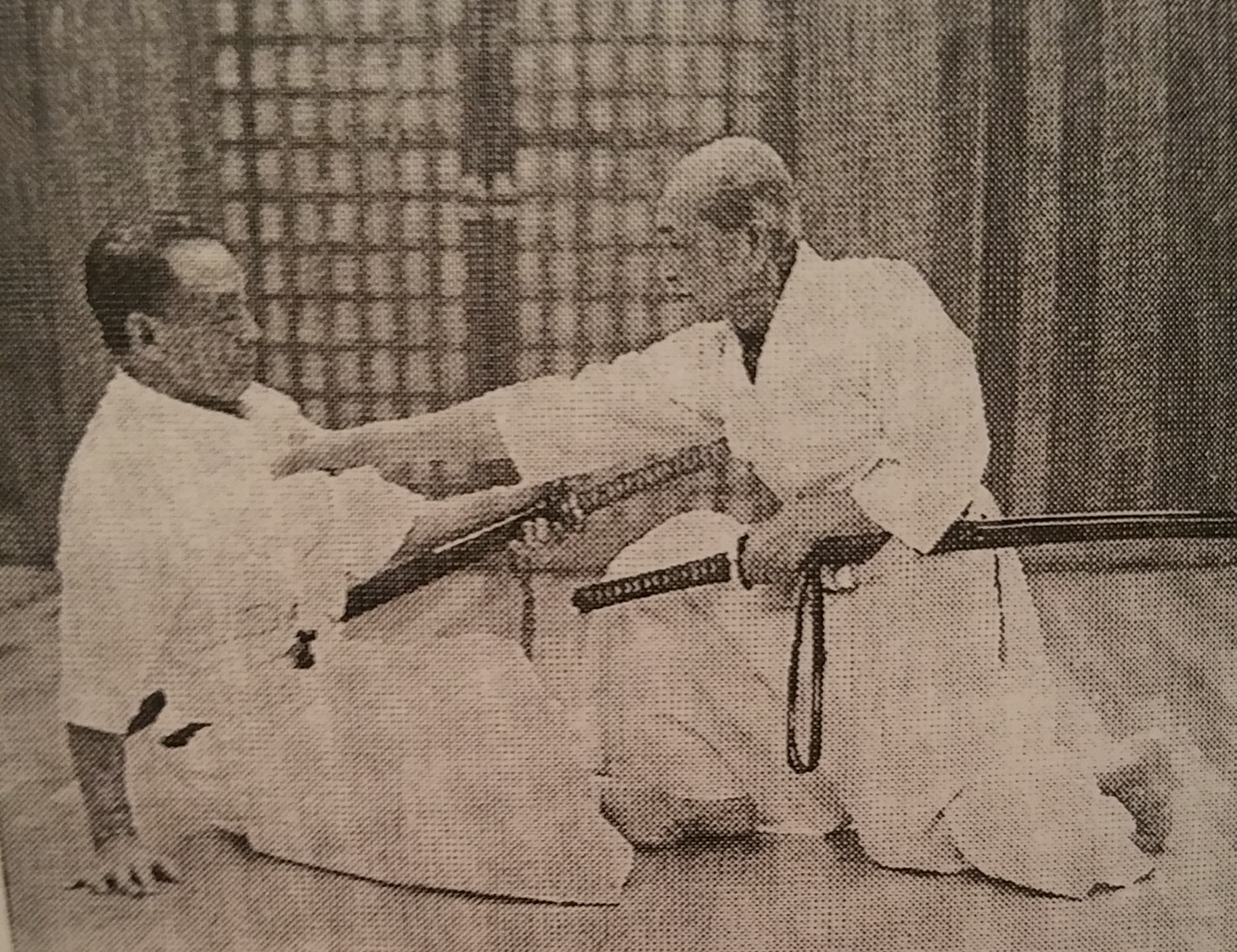 Musō Shinden Ryū, Daishôzume, Munedori. Source: Iaido: Sono Riai To Shinzui, Danzaki Sensei.
Musō Shinden Ryū, Daishôzume, Munedori. Source: Iaido: Sono Riai To Shinzui, Danzaki Sensei.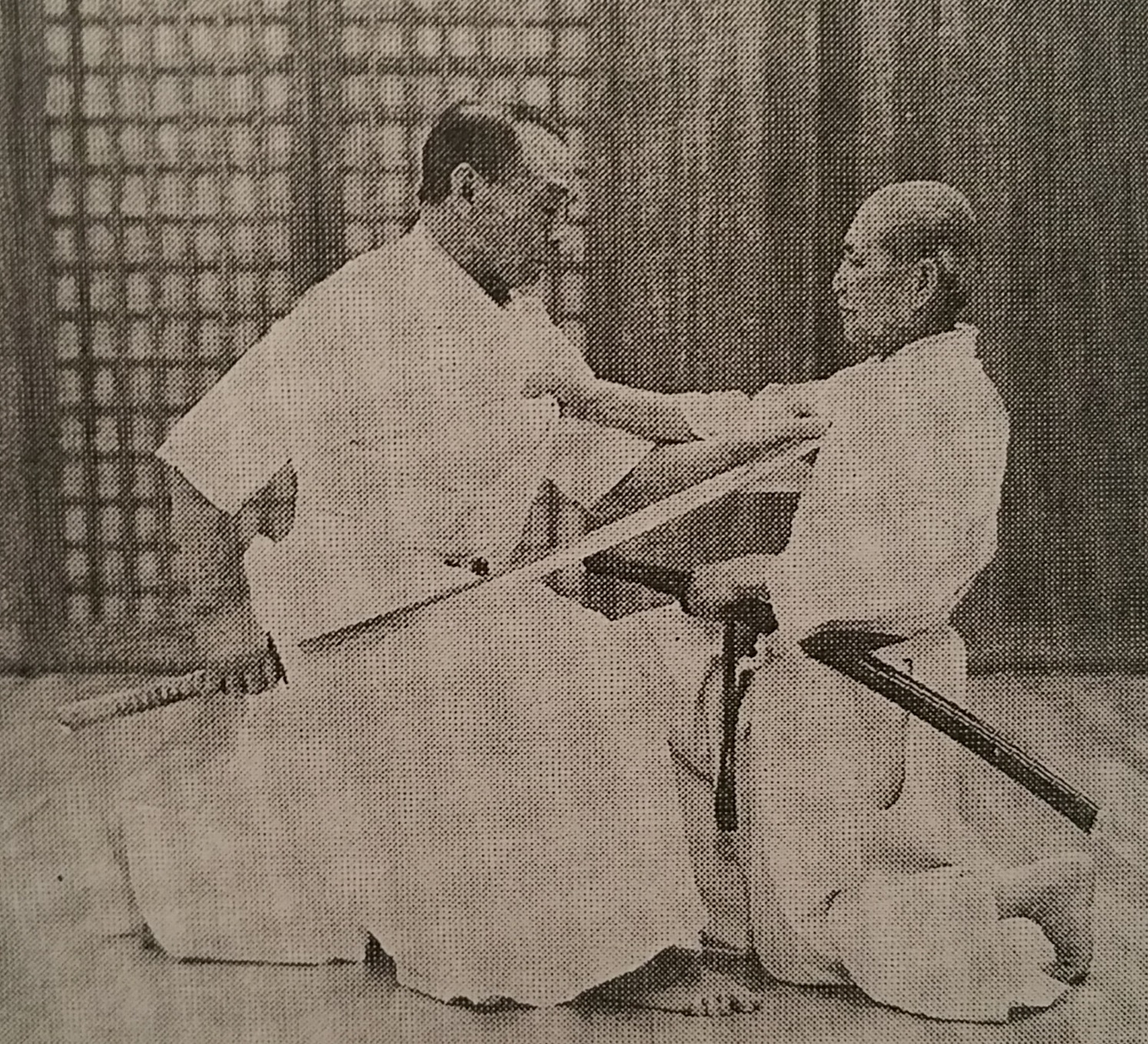 Musō Shinden Ryū, Daishôzume, Munedori. Source: Iaido: Sono Riai To Shinzui, Danzaki Sensei.
Musō Shinden Ryū, Daishôzume, Munedori. Source: Iaido: Sono Riai To Shinzui, Danzaki Sensei.Within this context, the opponent is grappling the swordsman and preventing a direct strike to his face or the solar plexus, thus the swordsman draws the blade to the right to draw and thrust in one movement. The ura (deeper level of understanding) of this technique contains no less than 6 additional responses and counters, made available through correct tactical understanding developed through the neuro-physical body organisation developed by the ryū.
Cummins Does Not Understand Iai
If that wasn't bad enough in this video Cummins attempts to use this small piece of text to utterly discredit koryu iai. He makes a remarkable error filled statement:
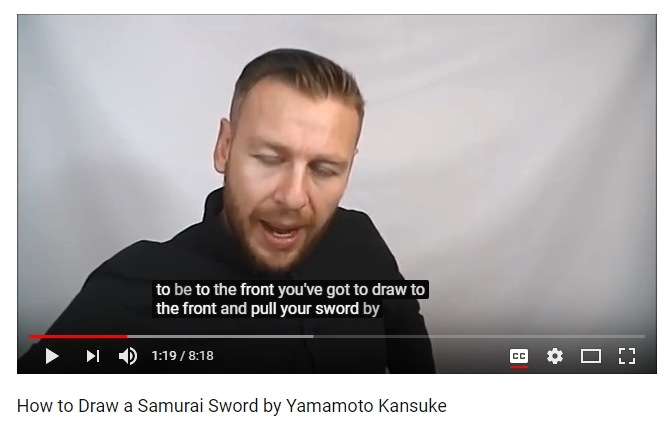 Source: YouTube
Source: YouTube"at the moment we all understand that in iaido in drawing swords it's got to be to the front, you've got to draw to the front".
- Antony Cummins, "How to Draw a Samurai Sword by Yamamoto Kansuke". 1:12
He continues with this absurd idea -
"this document on its own says that anybody who says you must draw in this manner, you know to the front...one document from the early 1600's is saying do not draw forwards....for me the idea that everybody does this one draw in the same way, and it's always very, very formulaic and static, it's just not good enough for me..."
- Antony Cummins, "How to Draw a Samurai Sword by Yamamoto Kansuke". 6:24
These allegations are utterly false and reveal precisely how little research Cummins has done. A quick Google search of any number of Koryu sword schools would show a variety of different draws.
I practice 2 schools of koryu Iai and one modern school of Iai and have studied several more koryu and there are multiple methods of drawing the sword taught in all of them. Forward is the first one generally taught because it is the easiest, however very quickly you are introduced to draws to the front, left, right, rear, up down, and multiple diagonal planes.
Heck, even modern standardised non-samurai schools of swordsmanship such as Seitei iai (which Cummins, in his "Having a go at Koryu" video, seemingly confuses with classical koryu iai) have in their 2nd form a draw to the left and rear. The 3rd form teaches a draw to the upper right diagonal. The 4th form teaches a draw directly to the rear. The 5th form teaches a diagonal draw from a reverse position on the left hand side to the upper right along a diagonal arc. The 7th form teaches a draw to the right and cutting at 45 degrees to the body with an angle on the blade....I could go on...in fact only 1 kata in the modern Seitei Iai draws to the "front" as Cummins describes - the very first one, Mae.
Each and every draw of the Seitei Iai kata is different.
In koryu Iai, nearly every conceivable method of drawing a blade is taught...
Including a draw to the right while in a grappling/wrestling situation....but that's not the only one - in Musō Jikiden Eishin Ryū and in Musō Shinden Ryū there is a standing draw, where the draw is to the right, the left leg goes back (as per the vague description Kansuke provides) and then...the opponent is stabbed. In Musō Jikiden Eishin Ryū we call it 岩波 Iwanami. Here's a clip -
Because Cummins has NO KNOWLEDGE of Japanese koryu swordsmanship he continues to make and promote false claims and absurd ideas such as all Iai draws are to the front.
Because of his lack of training and experience, he makes up ridiculous versions of limited text instructions that are unsafe, tactically useless and dangerous. Had Cummins been genuinely interested in he would have:
- Realised this was instruction for a grappling situation in a chapter on wrestling techniques
- Sought out instruction or footage of any of the primary schools of koryu
- Identified similar techniques and presented them as a possible and likely interpretation while...
- Acknowledging that each ryū has a unique method of physical organisation that requires years of training to truly understand a given technique and thus it is impossible to say for sure that the technique as described in the text could never be definitively or authoritatively be interpreted or recreated.
Instead, Cummins did this:
- Ignored the context and documentation
- Performed no research
- Made up a story of lies about koryu to suit his narrative
- Made up a technique
- Performed it badly
- Encouraged others to learn this substandard nonsense and post videos of themselves doing it.
This is not an isolated occurrence. In fact, this is his standard approach.
- Read a text.
- Make up a move.
- Claim the koryu are teaching and saying things they aren't so he can say that it's wrong and that they represent "Fake News".
- Present his made up move and encourage others to study it, practice it and submit videos of them performing unsounded and unsafe and illogical techniques that have no resemblance to samurai skills or combat.
It is in this context that Cummins best fits the criteria of a martial arts fraud as laid out Dave Lowry, a noted expert on Shindo Muso-ryū and Yagyu Shinkage-ryū and author of almost 20 books, primarily on the martial arts:
"...the other extreme are charlatans who have actually created their own systems, passing them off with faked lineages and other false provenances. All these problems share a common source. All may be traced back to some fundamental misunderstandings about the nature of the bujutsu and the koryu that have sustained and nurtured them"
Lowry, Dave; "The Classical Japanese Martial Arts in the West: Problems in Transmission", http://www.koryu.com/library/dlowry4.html (retrieved 27/2/17)
Cummins does not understand anything about koryu bujutsu and has, rather than invested in the hard work and study of koryu, just made up his own version and claimed the lineage of a dead school. What Cummins demonstrates simply makes no logical sense. I could go, but the Gudkarama YouTube channel did an excellent video series on this, and I recommend checking it out.
In a Natori-ryu instructional video titled, "Drawing a Samurai Sword in a Crowd", Cummins again references that he and his cohorts make these interpretations up; "what is interesting actually is Andrew Throburn came up with a different idea for this that I hadn't thought about". (Drawing a Samurai Sword in a Crowd 0:33). The video goes on to demonstrate a ridiculous interpretation of a technique where Cummins literally waddles with a sword between his legs.
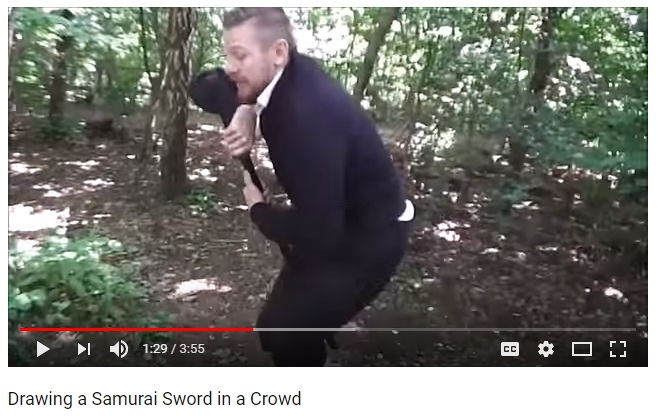 Antony Cummins waddling with a sword between his legs. Source: YouTube
Antony Cummins waddling with a sword between his legs. Source: YouTubeHowever, in all these examples, Cummins is interpreting a text and we have no real way of determining what is meant in those texts as they are written so as to be deliberately opaque, only those initiated into the style being discussed will understand truly what is meant.
It could be, however unlikely, that what Cummins is making up (which he has to do because these arts are not taught anymore) is correct (but we know with reasonable certainty that it isn't because trained soldiers/fighters/martial exponents of feudal Japan did not put sharp blades against their vital targets, create deliberate openings and then do nothing or waddle with swords between their legs, as all the extant systems show a highly developed sense of personal awareness, body mechanics, the dynamics of combat, strategy and... common sense).
As such, for this article I'm going to focus on a ryū that is still extant, that is still practiced and that anyone genuinely interested in studying or even doing the most basic of academic research into the martial arts would be familiar with. The school of Miyamoto Musashi; Hyoho Niten Ichi Ryū.
Antony Cummins Cannot Teach Go Rin no Sho
The images below are of Cummins teaching from the Go Rin no Sho are taken from a montage from his Katana v Pig (TEST CUT) video and no citation is given to the date or venue in which the above images were taken. In this Cummins states that;
"Here is an example of me teaching.....teaching's the wrong word, but exploring with the Go Rin no Sho, that's Miyamoto Musashi"
- Antony Cummins "Katana V Pig (TEST CUT)" - 17:26
He then proceeds to show a video of himself demonstrating 4 parries Musashi discusses in the Go Rin no Sho. I've screen captured the relevant moments below:
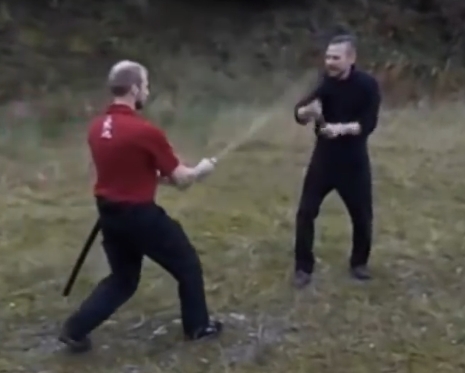 Source: YouTube Source: YouTube |
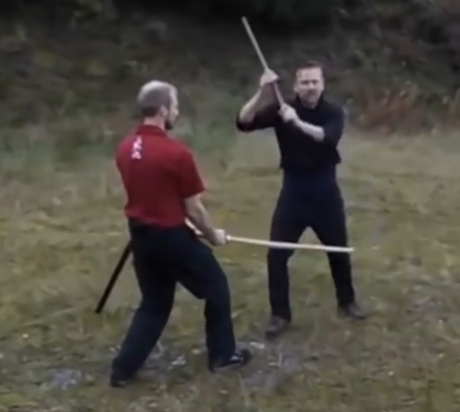 Source: YouTube Source: YouTube |
"The first one is the slap and bounce"
- Antony Cummins "Katana V Pig (TEST CUT)" - 17:56
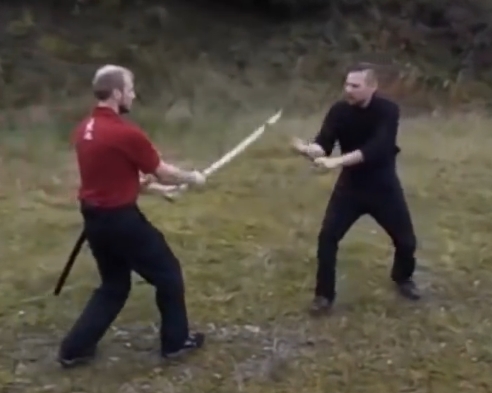 Source: YouTube Source: YouTube |
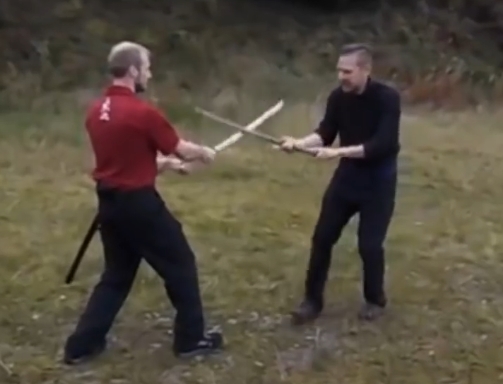 Source: YouTube Source: YouTube |
"As he comes in we receive"
- Antony Cummins "Katana V Pig (TEST CUT)" - 18:08
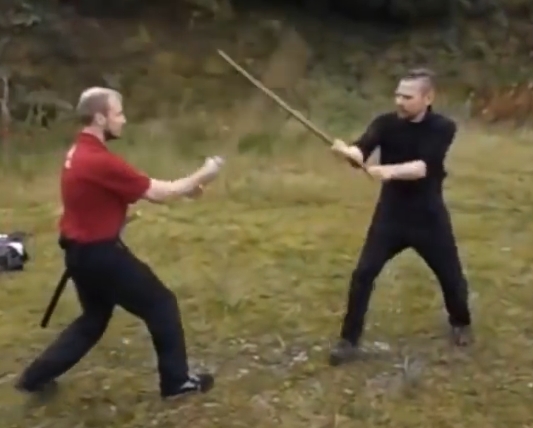 Source: YouTube
Source: YouTube"Strike through"
- Antony Cummins "Katana V Pig (TEST CUT)" - 18:25
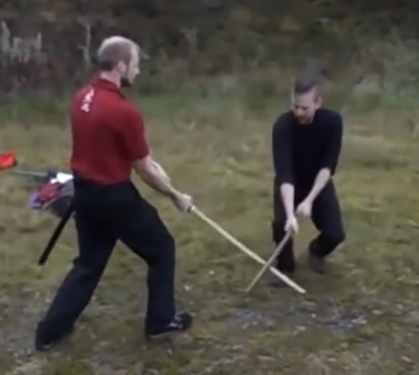 Source: YouTube
Source: YouTube"Holding down the blade"
- Antony Cummins "Katana V Pig (TEST CUT)" - 18:46
(An additional note on this, after demonstrating a technique, Cummins likes to slide his hand up and down the blade length of his bokken - this is problematic for two reasons the fist, being that if you did that with a sword you'd slice your hand off, the bokken represents the sword and should be treated as if it is a sharp blade. This is to teach the student proper neurological and physical organisation around the sword.
Secondly, practically that is dangerous. He is engaging in contact with bokken, they splinter. Running his hand unconsciously down the length of the blade edge as he does so frequently will increase the likelihood of a splinter cutting him - this is unsafe conduct in any dojo).
He further states that "Everything is very short and sharp" (Antony Cummins "Katana V Pig (TEST CUT)" - 18:57), referring the movement of Musashi's technique. Then he demonstrates how NOT to cut (which ironically is closer to how one should cut as directed by the text of the Go Rin no Sho and Musashi's school) vs. how to cut (which is a clearly, an off balance stance more suited to an anime than bujutsu).
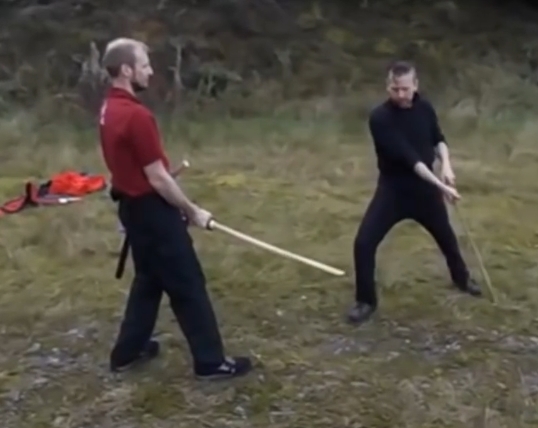 Figure 1 Cummins says this is INCORRECT. Source: YouTube Figure 1 Cummins says this is INCORRECT. Source: YouTube |
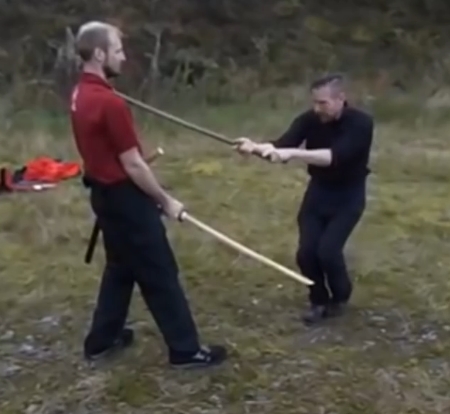 Figure 2 Cummins says this is the CORRECT way Musashi would have cut. Source: YouTube Figure 2 Cummins says this is the CORRECT way Musashi would have cut. Source: YouTube |
Of course the actual Go Rin no Sho states the exact opposite of what Cummins teaches:
"The way to use the tachi is not to swing it quickly...The tachi has to be swung in a wide space"
- Miyamoto Musashi, Go Rin no Sho, 1.4 (trans. Miki Takeshima)
"Then swing strongly extending your elbows fully, this is the line of the tachi. (When you swing extend your arms.)"
- Miyamoto Musashi, Go Rin no Sho, 2.7 (trans. Miki Takeshima)
"your tachi follows your thoughts and becomes slow (graceful) like water in a pool and you hit big and strong. After you master this way, you will be able to hit nicely".
- Miyamoto Musashi, Go Rin no Sho, 2.18 (trans. Miki Takeshima)
"Understand the way of the sword, realize the strengths or weaknesses of the opponents (style or sword), master the use of the whole sword, and train to beat opponents. Hence, small techniques are not strong enough movements, and are not worth thinking about". (alt translation: "you will err by using "short sword chopping". You cannot cut a man with a long sword using this method")
- Miyamoto Musashi, Go Rin no Sho, 3.0 (trans. Miki Takeshima)
"Especially for the way of hyoho, to “rush up” is bad..Try to cut quickly, unlike fan or short swords, it won’t be able to cut at all"
- Miyamoto Musashi, Go Rin no Sho, 4.8 (trans. Miki Takeshima)
In summary, Musashi advocates big, wide, simple movements performed at the correct speed. This is the exact opposite of "short and sharp". Keep this in mind, as a common thread of Cummins' work is to dismiss any documented evidence that contradicts his "feeling" of what he has made up.
Why Does Cummins Focus on Musashi?
Cummins states that despite publishing a "translation" (see my earlier entry - Why Antony Cummins does not provide translations), of the Natori School of Samurai Arts he does not take his method of fighting from this text;
"not for fighting, but for Samurai History"
- Antony Cummins "Katana V Pig (TEST CUT)" - 14:47
"You have to think of Natori Ryū as everything that is NOT the martial arts"
- Antony Cummins "What is Natori Ryū" - 1:37
In another video titled "Are there any Martial Arts in Natori Ryū?" he continues to clarify this:
"The simple answer to this is no, there are not...So if you've come to Natori Ryū to study martial arts that's not the place"
- Antony Cummins "Are there any Martial Arts in Natori Ryū?" - 0:12
So where does Cummins receive his martial arts education and skills from?
"I tend to stick with Musashi, ad Go Rin no Sho, and so if you want to know where I get my information from, predominantly it's Go Rin no Sho".
- Antony Cummins "Katana V Pig (TEST CUT)" - 19:57
And then by way of example demonstrates the 4 parries shown above. And here's the problem with this...these parries are:
- incorrect,
- dangerous and
- not how they are performed in Musashi's school of swordsmanship.
What he is doing is reading a translation of text, which has varying levels of accuracy, and then making up what he thinks that means. And then teaching it at the seminars that he has uploaded video of and in the "Natori-ryu School", for financial and personal gain (again, the very definition of a fraud via the Oxford Dictionary), and something Musashi himself would highly disapprove of. Had Cummins actually studied the Go Rin no Sho, he seems to have dismissed this part of the document too.
Secrets of the Ryū
Here's the thing - it is impossible for anyone outside of the ryū, any ryū, to understand the mechanics and philosophy (Mu = Way) based on their documents. The reason for this is very simple. These documents were written in such a way so as to be deliberately vague, to obscure the meaning to outsiders and only allow those initiated into the ryū to understand what the technique being referred to is and how it was performed. No amount of documents, images and video can truly transmit koryu bujutsu.
For example here is some documentation on the Eishin Ryū, one of the koryu schools of Iai that I study:
Tora no Issoku
The fierce tiger has no trouble in crossing a thousand miles for his hind leg moves faster forward than his fore leg to take the next step.
Inazuma
Both see the flash of lightening, but he will not hear the crash of thunder
(M. Yamakoshi and K. Tsukimoto, Muso Jikiden Eishin Ryu: The Oral Traditions of the Yamauchi Branch, Kyoto, Maruzen, 2004)
Neither of those will make any sense whatsoever to anyone outside of the ryū. But they make sense to those who have trained in the ryū. The first explains the movement, speed and timing of a particular form. The second explains the nature of the draw of particular form and the decisive cut, but also illuminates the timing, distance and speed of that form. But without the context - it's impossible to develop the correct technique from these writings.
The same is true with Musashi. The Go rin no Sho is an internal work, written for Musashi's students.
"To quote Sosnowski, MD (Prelude to Translation 2005): “The most famous bodies of literature were written in Biblical Hebrew, Classical Latin, Sanscrit, Classical Chinese etc. Not in English. Due to this fact translated works are open to varied interpretation based on experience”.
In the case of Gorin no Sho translations up to now show a definite ‘lack’ of experience of the writer/interpreter.
Some foreign words do not even have direct rendition. Translation from another language gives the choice to the interpreter to substitute his own words based on his vocabulary. The thing is one word alone can vastly change the meaning of the text.
We can add to this one more problem. Gorin no Sho was written in Japanese Medieval times. At that particular time education was and still is drawn from Confucian and Buddhist meanings. In reading these works one can find the real and hidden deep meaning in Japanese/Chinese calligraphy...
...Gorin no Sho was written for his students...
...In reading Gorin no Sho is it simple to understand? Prof. Karl Friday (Dept. of History, University of Georgia) contends that the lack of accuracy in translations is the result of inadequate background knowledge of a subject...
...I have read all the published translations.. they all miss out to a large extent of what Musashi relates to us."
Colin 'Hyakutake' Watkin - Hyoho Niten Ichiryu senior practitioner, "The Go Rin no Sho Of Miyamoto Musashi", Sei Do Kai Productions, 2014, Kim Taylor.
The simple fact of the matter is that you cannot "recreate" or invent an accurate interpretation of any koryu school, even with the documents, if you have not trained in that art and developed the kinaesthetic awareness, body organisation , neurology and philosophical outlook developed through rigorous training in the ryū.
Musashi himself fundamentally believed this. For example the Hyōhō Sanjū-go Ka Jō ("Thirt-five Articles on Strategy"), written specifically for Lord Hosokawa, sees Musashi frequently refer back to actual physical training in the ryu;
"In addition, this style is practised and acquired individually, as the specifics of movement of the sword, and other such things which are conveyed orally; do not need to be written down"
Miyamoto Musashi - The Five Rings; Miyamoto Musashi's Art of Strategy. Trans. Groff, David K.
As I've noted in other articles, there are more to koryu than just the techniques. There are the intrinsic religious and spiritual beliefs of Shintō, Taoism, Confucianism and Esoteric Buddhism, woven through the fabric of every technique. To explain just a superficial understanding of these took me two books! ;-) This is how deeply embedded into the fabric of the koryu are these idea's not to mention the societal and historical influence's brought to bear upon the koryu.
Musashi himself writes as much and cautions against frauds such as Cummins at the very start of the Go Rin no Sho:
"Simply learning sword skills, it is impossible to understand the skills of the sword. Needless to say it doesn't come up to hyōhō. [Although some people are claiming that they are teaching the full way of the sword, they are only teaching techniques. You can't learn hyōhō by only learning techniques]"
- Miyamoto Musashi, Go Rin no Sho, 1.1 (trans. Miki Takeshima)
What does Musashi mean by this? Well, for example within the Hyōhō Niten Ichi-ryū the influence of In and Yo (Yin and Yang) are deeply entwined within the ryū. The first clue is within the name the of the School - the Two Heavens Under One style is the common translation of Ni (Two) ten (Heavens) Ichi (One) Ryu (Style) - the two heavens here can imply the dual nature of Yin and Yang. Alternate translations further reflect this, suggesting two swords, one entity. One sword is used by the Yin side of the body, often for defence and redirection, the other side, the Yang side of the body used for aggressive attack. Thus in unifying Yin and Yang in body and mind, one becomes undefeatable.
This understanding of In and Yo is so fundamental to Musashi's teachings it serves as the literal foundation for his style of combat and strategy. And yes, while Musashi alludes to it in his text...
"There is an important way of stepping in this category called “in-yo” this is essential."
- Miyamoto Musashi, Go Rin no Sho, 2.5 (trans. Miki Takeshima)
...that's pretty much all he says...a full explanation of this teaching (the Ura) is restricted to students of the school, but it is not the only instance of In and Yo within Musashi's strategies or writings. Further later higher level kata within the Hyōhō Niten Ichi-ryū take their names from these very principles for example in the study of Bojutsu we have kata called In no Hiki Bo and Yo no HIki Bo, where we literally manifest In and Yo with particular Kamae (postures).
Of course Musashi himself only gives the briefest of explanations in the Go Rin no Sho on any matter as it is was not written for a general audience. It was written for ONE student, Terao Magonojō.
"The particular recipient he addresses the five scrolls of the Go Rin no Sho was Terao Magonojō, brother of Terao Motomenosuke (who eventually received the "Thirty-five Articles on Strategy") and one of the three men entrusted with the continuation of the Ni Ten Ichi Ryū school. As accomplished swordsmen who had trained countless hours with Musashi, these words would largely have been reminders of what they had already learned under Musashi's tutelage".
Miyamoto Musashi - The Five Rings; Miyamoto Musashi's Art of Strategy. Trans. Groff, David K.
In fact, it is important to keep this in mind with all of Musashi's texts. They were written for specific people, to convey specific ideas to them, based on the fact that they had been training with Musashi sometime.
"in reading these texts it's important to remember that Musashi never meant them to be read by a wide audience, or even for posterity; they were written for specific people with their background in mind. At one point he (Musashi) he even suggested that his students burn the texts..."
Groff - The Five Rings; Miyamoto Musashi's Art of Strategy. Trans. Groff, David K.
Musashi's texts are not a how to manual but more of a crib notes reminder series for his students from which they can extract the greater teachings taught in the school itself. These are teachings that have been taught in the dojo through oral instruction and hours of physical training.
The koryu, and certainly Musashi's teachings, put forth in the Go Rin no Sho and as practiced in Hyōhō Niten Ichi Ryū can be understood only through the rigorous training of the body. It is this training, not book reading, that organises the body, physically and neurologically to perform the techniques of the ryū. This too is something Musashi talks about - in fact close to 80% of the text finishes a specific bullet point with -
"...you will never be able to achieve this without hard training"
"Practice hard"
"Practice this carefully again and again".
"We have to take the tachi in hand and practice hard".
"You should put more effort into practicing".
"You should take a tachi and train practically".
- Miyamoto Musashi, Go Rin no Sho, (trans. Miki Takeshima)
Of course this is an immediately understood principle of EVERY genuine koryu. It's about hard practice, shaping the body and mind to the demands to the ryū. Not adjusting everything to suit yourself.
"you don’t join a school and learn the choreography of a sword fight. The kata are pattern drills, and those forms sometimes have more to do with how to organize the body, how to develop a specific physical or mental attribute, rather than a simple technique detailing “if he does this, then you do that”. Sometimes a given element is so important that the kata may not look very martial, even sloppy or stupid to an outsider, but what it is developing has nothing to do with a replica of “combat”, but to train a specific attribute".
- Ellis Amdur, "Being Old School: An Interview with Ellis Amdur on the Classical Martial Arts of Japan", (https://freelanceacademypress.wordpress.com/2014/11/06/going-old-school-classical-martial-arts/)
A Fossil is Not a Dinosaur
And this is why Cummins, above all things (like his lack of understanding of documents, martial culture and physical technique), absolutely cannot claim legitimacy or that what he is teaching are REAL samurai skills. Because he is recreating his nonsense from a dead school, from obscure texts that do not contain the full teachings, but only the barest of suggestions of techniques...and as Musashi himself writes - You can't learn hyōhō by only learning techniques.
Oral transmission from one person to another in the dojo is a defining characteristic of Musashi's school and koryu in general. As Wayne Muromoto writes in his blog, The Classic Budoka;
"the passing on of methods from one generation to the next, is an essential characteristic of a koryu. It is done from person to person, teacher or senior to student. For better or for worse, it is the ONLY way for anyone in a koryu to be considered a legitimate exponent of the ryū. You have to have learned it from a living, breathing person"
- Muromoto, Wayne; "72. Direct Transmission" https://classicbudoka.wordpress.com/2012/09/11/72-direct-transmission/ (retrieved 27/2/17)
Without direct transmission, without a living teacher to guide you in understanding the meaning of the forms, the philosophy and strategy behind them, the techniques themselves are nothing more than shadows cast on a cave wall by the flickering fire of actual Budo practice. And Cummins doesn't even have those shadows. For the most part he has a copy of what someone vaguely suggested was a shadow. Yet he has the audacity to claim that the figments of his imagination, as he grasps on to shadows are somehow more authentic and accurate then living, breathing, physical, real traditions, that have unbroken lineages? How does that make sense?
Ellis Amdur is a highly acclaimed martial artist and author. He also happens to be Shihan (licensed instructor) in Araki-ryū torite kogusoku and the Toda-ha Buko-ryū. Upon the release of the 2nd updated edition of "Old School" he was interviewed and asked about, among other things the issue of resurrecting a dead school:
"Reinvention is taking something dead and using written records alone to recreate it. The results vary on the quality and prior knowledge of the reinventor...But is it really the same school, or something new? Do the reinventors really “have it” from the inside out? They can’t — it’s dead, and a fossil is not a dinosaur. They do not have the essential teachings that were the life-blood of the school, things that are usually transmitted not only orally, but through crossed weapons or body-to-body. And honestly, what’s the point? Why revive an extinct naginata school, for example, when there are perfectly viable extant schools that one could join, and pay one’s dues, earning a level of true expertise. It’s like going to the museum and climbing onto a stuffed horse to ride, when next door, there are stables full of quarterhorses and Appaloosas".
- Ellis Amdur, "Being Old School: An Interview with Ellis Amdur on the Classical Martial Arts of Japan", (https://freelanceacademypress.wordpress.com/2014/11/06/going-old-school-classical-martial-arts/)
Cummins rides stuffed horses and claims to be the world's foremost expert in horse riding, then charges others to teach them horse riding...all while never having ridden an actual horse.
The entire endeavour and claim to teach "real samurai skills" or anything of the Natori ryū is fraudulent. Any claim to the contrary is simply untrue. The teachings have been dead for over 100 years. The texts are unreliable and openly disputed in every legitimate academic circle. For instance, Cummins' first publication of a Natori document is the Shōninki.
"Watatani and Yamada (1978: 215) and various other historians consider this document {the Shōninki} and others related to Kishū Ryū to be unreliable"
- Halls. Dr. David; "The Encyclopaedia of Japanese Martial arts pg. 459
" Watatani and Yamada (1978: 215) are very critical of this document, {Togakure Ryū kudenso} noting that it is filled with fictional accounts and is highly unreliable. They also consider the Shōninki, a transmission document (densho) attributed to the Kishū Ryū, to be unreliable.
- Halls. Dr. David; "The Encyclopaedia of Japanese Martial arts pg. 264
But let's come back to Musashi...
Antony Cummins and Miyamoto Musashi
Let me make this very clear, Antony Cummins, has not, and never has been a student of Hyōhō Niten Ichi ryū, nor has he been a member of the Enmei-ryū, or the other offshoot schools of Niten. He is not authorised to teach Niten Ichi ryū and has no knowledge of the style. Despite the fact that he has no formal training or understanding of the techniques, Cummins advertises himself as a teacher of Musashi's style. Again, categorically, I repeat he is not.
By contrast, I am a student of the Hyōhō Niten Ichi ryū, Musashi's actual style. In fact I am the dojo-cho (leader) for my country having received direct permission from the current Soke Kajiya Takanori in 2014 and I have been studying Hyōhō Niten Ichi ryū for 8 years at the time of writing.
What Harm is there in Cummins Teaching Musashi's Methods?
Now, you may rightly ask what harm is there in Antony Cummins teaching the principles of the Go Rin no Sho, well, there are a few.
Firstly his reading of the Go Rin no Sho is dubious - for more on that read my earlier article on Anthony Cummins is a fraud for more on the problem of what he is reading. As we've already seen Cummins cherry-picks his information, disregarding anything in the text that contradicts his imaginings. I'll come back to this with another example a little later.
The second problem is his interpretation - it's wrong, very wrong and makes no sense when viewed in the context of the
A) The available and accessible teachings and
B) in the light of practical combat.
The third problem is WHY he is doing this and that's I'll cover at the end of this article. For now, let's tackle the second problem.
It would be exhaustive to list and fully explain all of the problems evident in Cummins "teaching" of Musashi's techniques so I'll limit myself to perhaps the clearest and most obvious example, that of the second demonstration he performs of the receiving block. Within the teachings of Hyōhō Niten Ichi ryū, Musashi's actual style, the Go Rin no Sho being a text for his students (never intended for those outside of the ryū-ha) there are several different methods of receiving a sword, depending on whether you are armed with a katana, a wakizashi, jutte, bo or even unarmed. None of them resemble Cummins authoritative imaginings.
Before we get into any of those discussions, during the teaching demo, Cummins' opponent delivers the cut well outside of cutting range. There is no way the opponent can hope to cut Cummins at the distance they are at. And this is the first problem, one that runs through all Cummins' Go Rin no Sho demonstrations - the distance is wrong. Focus on correct distance is a key principle of Musashi's art and something he stresses within his various texts;
"make the distance between you and your opponent such that you can hit him in one timing".
- Miyamoto Musashi, Go Rin no Sho, (trans. Miki Takeshima) 2.15
"you and your adversary are both in position to hit the other, understand the moment when you opponent cannot react, and strike without moving your body..."
- Miyamoto Musashi - The Five Rings; Miyamoto Musashi's Art of Strategy. Trans. Groff, David K. pg. 102)
As such when training in Hyōhō Niten Ichi ryū, each cut, both from Uchidachi and Shidachi is performed with correct distance. This means that if the Shidachi was to remain static, or fail to execute the prescribed technique, Uchidachi would be able to effectively cut them. Musashi would not waste energy responding to an attack that is not going to hit him, hurt him or impede him. As we see in other techniques within the ryū he would likely just step, gaining correct distance and stop the opponent with a well placed thrust. In fact this is the first technique in the school's Ittō syllabus.
In his demonstration of receiving Cummins waits until the Uchidachi has cut and completed that cut, before he steps in, as Uchidachi was cutting nearly a foot away from Cummins' position (which, again makes no tactical sense - why cut into open air?). Cummins then steps in, places his sword on the ura (inside) of Uchidachi's blade before pressing that to Cummins right hand side - positioning Uchidachi's blade with the cutting edge facing Cummins body and leaving it free to cut Cummins torso or leg. In fact in the last demo of this movement Cummins inadvertently guides the opponent's sword to his own right knee. Obviously this is not safe, practical or efficient. I highly doubt Musashi would advocate guiding an opponent's sharp edged blade, to any part of his body. That's not an effective parry.
Let us contrast this with how this movement is taught in the ryū. The first version of the receiving parry is taught in the 4th kata of the opening set of sword kata, and the technique is aptly called Ukengashi, which means receiving or flowing block.
In this kata, both opponents walk towards each other and when Uchidachi is at the correct distance, meaning his next step forward will bring the cut he delivers with it to the opponents head, cutting with the Monouchi (the first third of the blade) directly to the Shidachi's head. Shidachi makes a small step inwards and slightly off the centreline. This is done for a number of reasons, two of which are - it removes Shidachi's body from the cutting line, keeping him safe, and secondly in stepping inwards you have stepped inside Uchidachi's cutting ark, rendering his cut less effective.
However in addition to the stepping motion, Shidachi uses a receiving block, this is an angled block to Shidachi's left hand side (if he steps to his front right hand side that is), this catches Uchidachi's sword at the point it is committed to the cut and slides it to the left hand side. Further, the angle presented by Shidachi's sword, continues to protect Shidachi's body from any further cuts from Uchidachi. At which point Shidachi can confidently counter having taken Uchidachi's centre and opportunity.
As such there are at a bare minimum 5 crucial elements present in the actual kata taught by the actual school associated with the Go Rin no Sho not present in Cummins invention;
- Correct distance
- The block actually receives the blade and redirects it through continuous contact
- Prevents Uchidachi from transitioning into another attack
- Secure a centreline position for Shidachi
- Provides the correct attacking distance for Shidachi while simultaneously negating Uchidachi's position
By contrast, Cummins teaching of this technique is an apt example of every technique Cummins demonstrates from the Go Rin no Sho. To Summarise;
- The attack is not realistic - distance and timing are incorrect, as the opponent is far outside the range of a successful attack, meaning the defender has to step in after the attack to affect their techqniue.
- Strategy is inconsistent with what is taught within the school and the Gorin no Sho
- Parries fail to adequately defend and serve their purpose
- Shidachi's counter position is weak, unbalanced and flawed leaving them unable to recover or counter.
The real tragedy of this is that Cummins has positioned himself as a researcher who uncovers the "real secret truths". But he has clearly done NO research. Legitimate examples of Musashi's receiving parry are not hard to find and takes less than 60 seconds to find on Google. Here's a quick example:
The particular technique I'v been discussing begins at 8:49
As I think is now clearly demonstrated, Cummins simply is not equipped with the training background, martial culture or strategic experience to competently interpret any translated martial arts texts.
"Do I make up what I am doing? No, of course not, I don't make it up".
- Antony Cummins, "Katana v Pig (TEST CUT) Video - 13:47
Yes. Yes he does. In fact, nearly every video in which he teaches or demonstrates a technique - he's just made it up. He's read something or imagined something and....made up what he thinks that means.
Sacred, Magic Documents - Until They Break the Fantasy
He dismisses the koryu teachings as unreliable because they have changed things (koryu bujutsu are living transmissions - they have, from their inception, added, adjusted and refined as they are meant to.) Instead Cummins relies on documentation (which we have seen he cannot correctly interpret) for truth and veracity of samurai teachings:
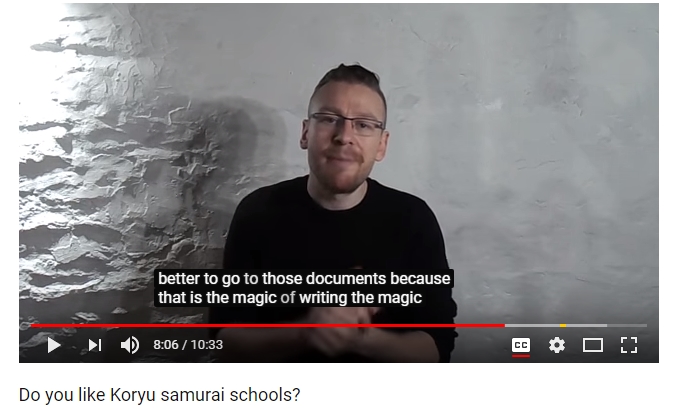 Source: YouTube
Source: YouTube"We shouldn't trust koryu explicitly. I prefer to go to the original documents because that is the magic..."
- Antony Cummins, "Do you like Koryu samurai schools?" - 7:44
This is another repeated trend of Cummins' videos - do not trust koryu. The koryu are not realistic samurai combat. Trust only the written material. Hence why he studies and takes his martial teachings from the Go Rin no Sho.
Except of course, when facts and written information come to light in those written texts which directly contradicts his imagined version (Cummins says Musashi teaches "short and sharp" cuts. By contrast Musashi himself actually writes in the Go Rin no Sho that short and sharp techniques are worthless, and instead your cuts should be big, powerful and performed at the right speed)....so he dismisses the texts because he likes how what he does "feels";
"Musashi says, keep a straight back. He actually says keep a straight back. So against the other koryu and against me, in the book I actually study he says straighten your back, but I feel more comfortable (demonstrates his odd hunchback stance)"
- Antony Cummins, "Katana v Pig (TEST CUT) Video - 20:15
This is NOT what a legitimate historical researcher does. They do not rely on what they "feel" is more correct - they rely on evidence; Archaeological, Iconographic, Documentation and Living Traditions such as the koryu etc. Cummins dismisses all of that, dismisses what Musashi actually wrote, because;
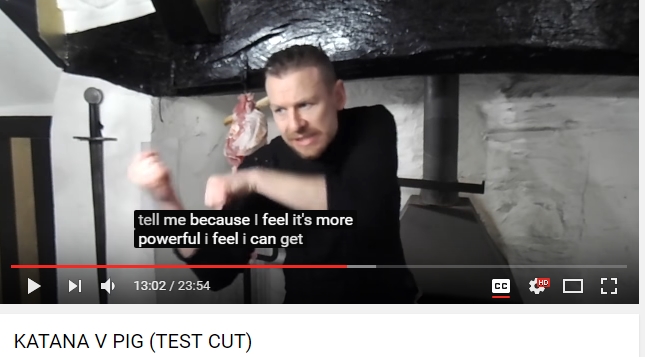 Source: YouTube
Source: YouTube"I hunch over because I feel it's more powerful, I feel I can get more power...I feel more comfortable". (Emphasis is Cummins').
- Antony Cummins, "Katana v Pig (TEST CUT) Video - 13:00
Despite claiming to learn his swordsmanship from the Go Rin no Sho - Cummins, makes up his own flashy "short and sharp" versions from a few lines of text, that bear no resemblance to the real samurai skills of Musashi. He populates his YouTube channel with flashy videos of "real samurai skills" that are neither real nor realistic. He populates his videos and books with lies and sensationalism in order to generate sales and build a reputation that he is not entitled to. Musashi would be appalled;
"Making the arts pretty to make a living from teaching them won't bear any fruit. A little learning is a dangerous thing."
- Miyamoto Musashi, Go Rin no Sho, (trans. Miki Takeshima)
"Read and understand all of this book and make it your own without simply looking through and mimicking" (alternative translation: "Do not just read, memorise or imitate")
- Miyamoto Musashi, Go Rin no Sho, 2.0 (trans. Miki Takeshima)
So to summarise, Cummins:
- Takes techniques from old texts, which he cannot read in the original language
- Relies on a variety of English translations, from decent to highly dubious
- Does no research
- Makes up his own version of what he thinks these texts are saying based on what he feels and thinks is cool (nearly always these made up interpretations are impractical, dangerous and tactically flawed)
- Makes up lies and false statements regarding koryu, leading academics and historians, in a poor attempt to undermine any criticism from those in a position of authority ("Fake News")
- Claims that only the documents should be followed
- Ignores the documents when they contain information that contradicts how he "feels".
And then we come to the third problem - FRAUD for financial gain.
FRAUD for Financial Gain
Cummins is not a student of, or authorised to teach Niten Ichi Ryū nor is he qualified or capable of interpreting and teaching from the Go Rin no Sho. In fact he is not authorised to teach samurai or ninja martial arts by anyone. Cummins is not a legitimate historical researcher or qualified to interpret Japanese martial arts texts as shown quite conclusively in this article and the previous two entries. Yet he claims to be a "martial artist", "historical researcher", "teaching from the Go Rin no Sho" and teaching "real samurai skills".
He is none of those things.
"A person or thing intended to deceive others, typically by unjustifiably claiming or being credited with accomplishments or qualities."
Oxford English Dictionary - https://en.oxforddictionaries.com/definition/fraud
Antony Cummins is a fraud.
But these claims are not the only fraud Cummins commits.
Antony Cummins charges money through his Natori Ryū organisation to teach Musashi's art via the Go Rin no Sho.
Note: at time of publication Cummins' has apparently stepped away from teaching, handing that duty off to Andrew Throburn, a man who has received hamon - expulsion and excommunication from a school, the most serious sanction a martial arts school can issue.
Let me be very clear about this - Cummins has established an organisation, where in exchange for financial benefit he provides training and instruction in a style that he is not qualified to teach, has no training in, has no knowledge of and in fact, has MADE UP fanciful, incompetent, impractical movements and passes them off as "real samurai skills".
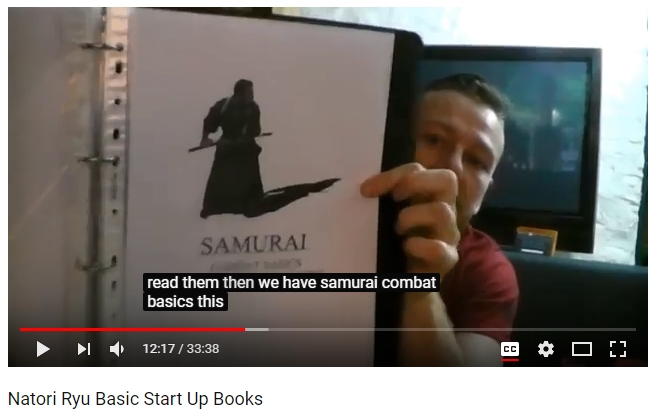 Source: YouTube
Source: YouTube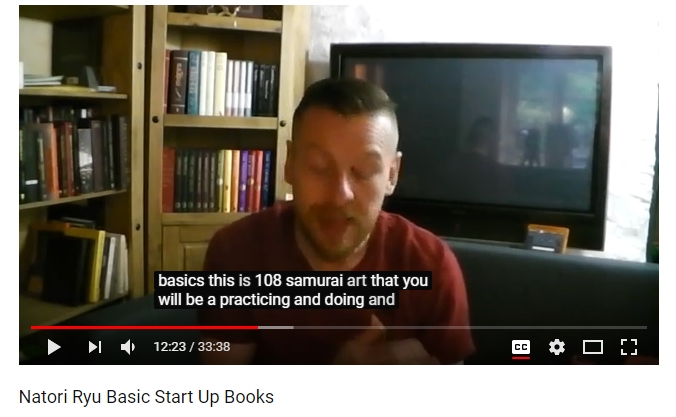 Source: YouTube
Source: YouTube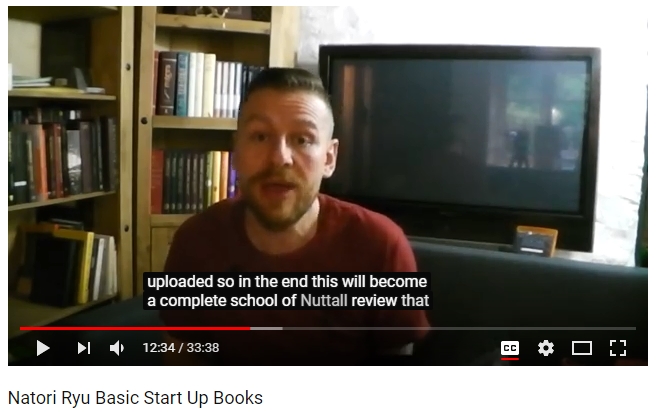 Source: YouTube
Source: YouTube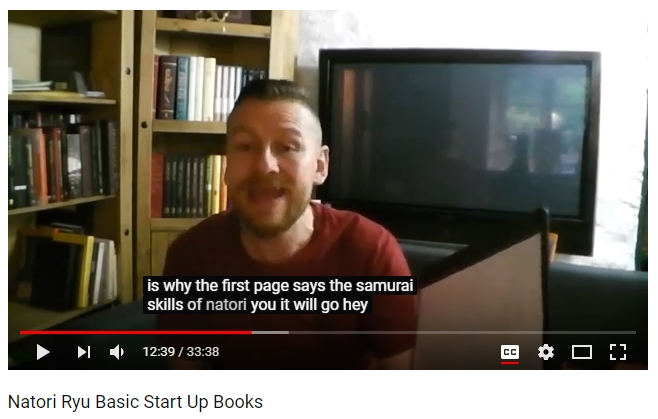 Source: YouTube
Source: YouTubeSo what are the "Samurai Combat Skills" taught in his Natori Ryū school? Here's a screen grab of the official documents:
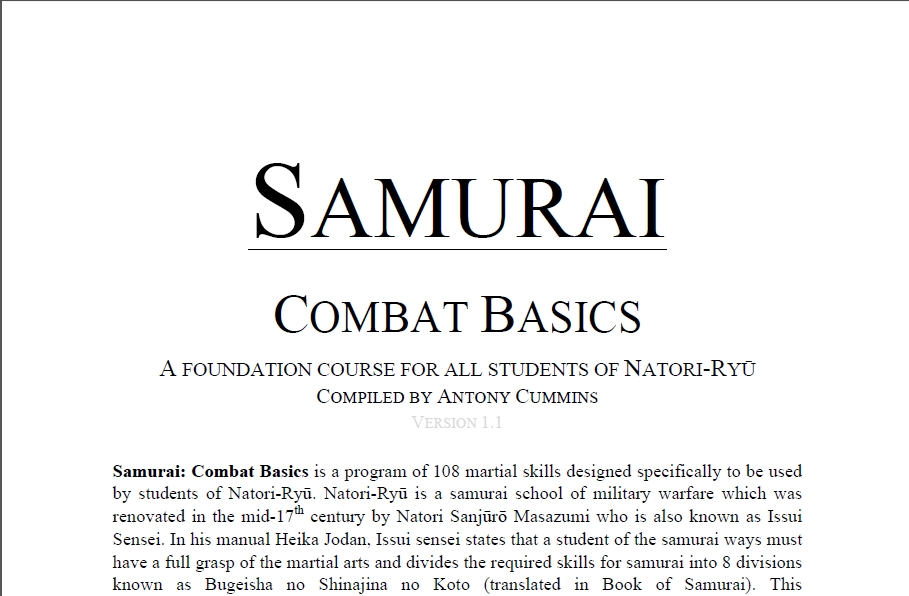
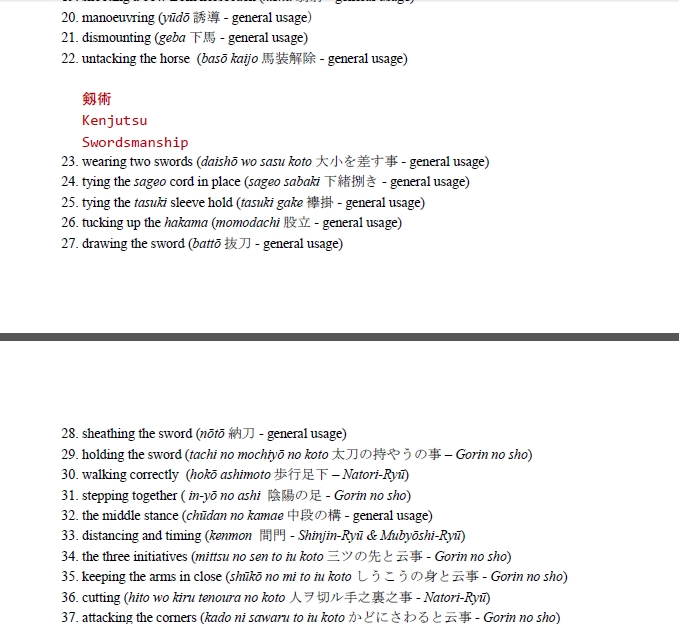
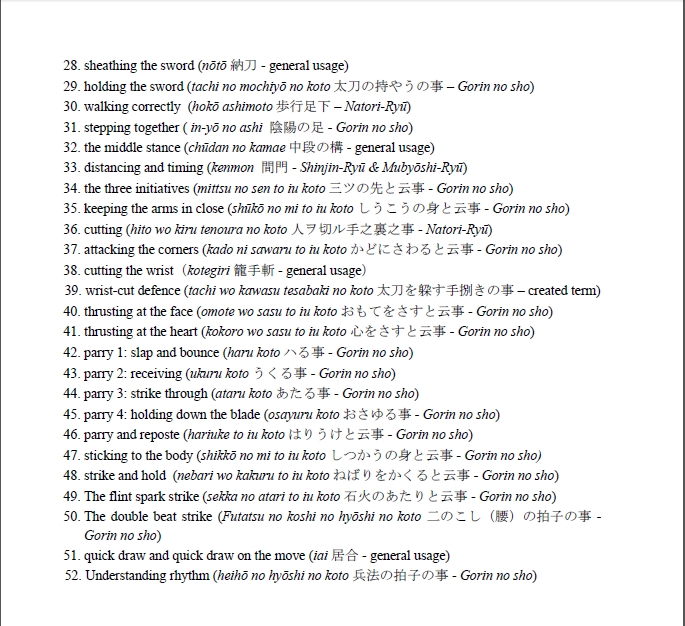
Of the 30 "Kenjutsu" skills listed in their curriculum, 17 are taken from the teachings of Musashi, which as I've shown Cummins has no understanding of, at all.
The rest of the document is much like this - a random collection of techniques stolen from YouTube clips and the imagination of Cummins from a variety of arts of which he has no training in.
This is, particularly ironic, as again - the "historical researcher", who prizes the documented word above all - ignores the written advice of Natori himself -
"Natori says that you shouldn't jump around between schools...In essence he says don't jump around martial arts don't grab a bit there, grab a bit there, grab a bit there....don't try to accumulate lots of different styles, it doesn't work..."
- Antony Cummins, "What Martial Arts should you study?" - 0:31
And later in the same video, Cummins himself acknowledges that:
"you need to study these things with a qualified teacher with reliable information"
- Antony Cummins, "What Martial Arts should you study?" - 0:59
And yet, despite the
words of the founder of the school he is abusing, Cummins has
essentially jumped around, grabbing things here and there, making up
his versions of these things and presenting them to a paying
public...and as we have seen in, he is neither qualified nor
reliable.
As for the subject of payment:
To register as a student of Natori Ryū costs - £10 GBP ("Natori Ryu Student Registration" Video)
In addition to this you are required to buy several of Cummins' books, the uniform, various additional expenses etc. Further there are now several "scrolls" of study where you can learn these made up versions of "real samurai skills" among others including Go Rin no Sho. The first scroll will cost about £290 GBP to complete.
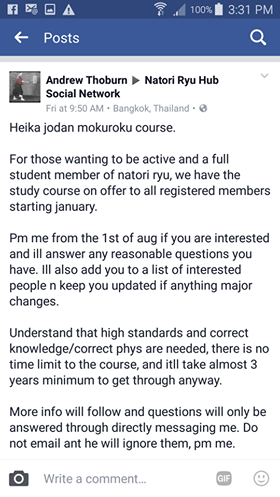 Image 1 Image 1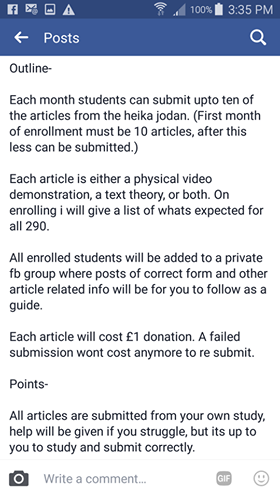 Image 3 Image 3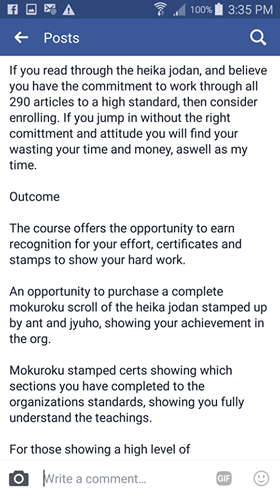 Image 5 Image 5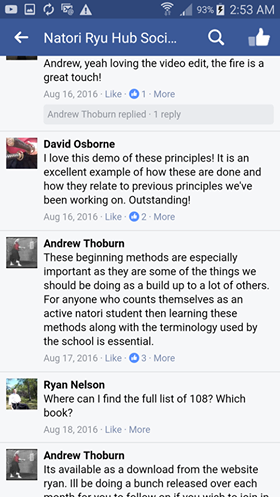 Image 7 Image 7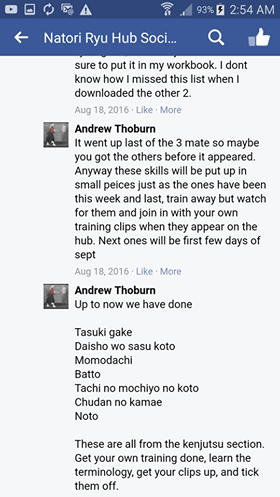 Image 9.
Images 1-9 sourced via Natori Ryu Facebook Hub Image 9.
Images 1-9 sourced via Natori Ryu Facebook Hub |
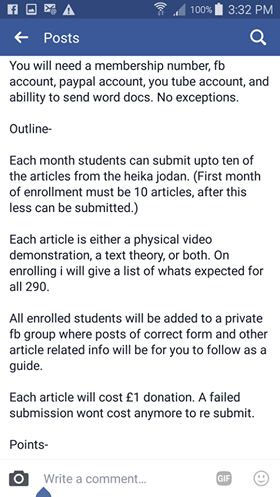 Image 2 Image 2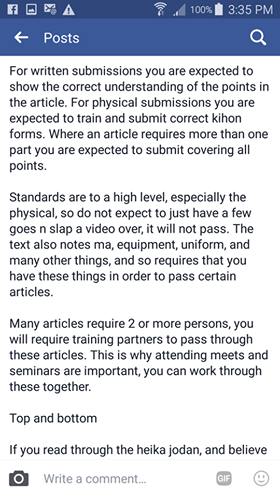 Image 4 Image 4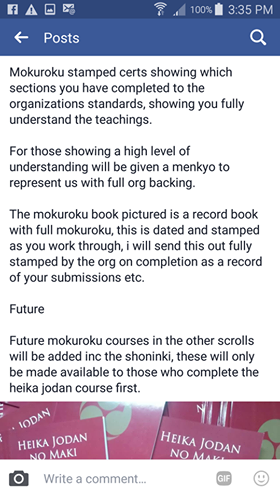 Image 6 Image 6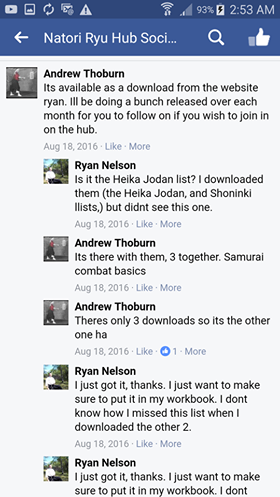 Image 8 Image 8 |
So the initial student
of Natori Ryū is looking at expenses of over £350 to learn
made up nonsense that is about as close to "real samurai skills"
as an episode of the Teenage Mutant Ninja Turtles.
That second definition of fraud again:
"wrongful or criminal deception intended to result in financial or personal gain"
Oxford English Dictionary - https://en.oxforddictionaries.com/definition/fraud
Antony Cummins is making up techniques, methods etc, lying about their provenance, deceiving people in his claims they are "real samurai skills"- including his made up teachings of Musashi and selling them, for financial gain.
That.
Is .
Fraud.
Click here to Return to the Way of the Samurai Home Page
Free Samurai E-books
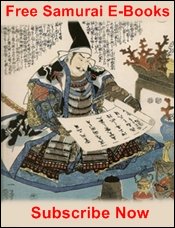
Get Free Exclusive Samurai Guides and E-books





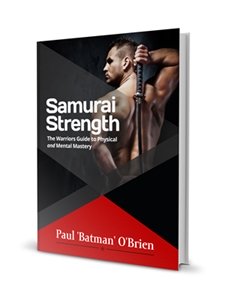
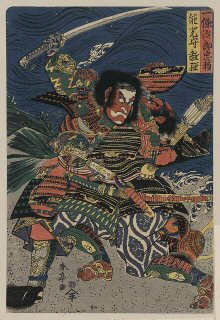
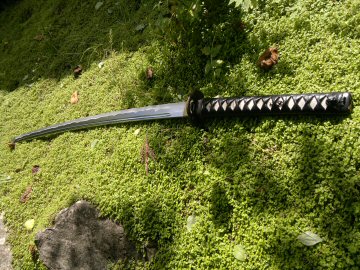
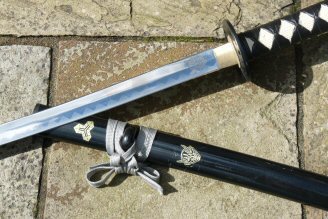
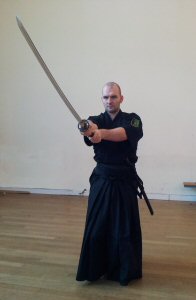
New! Comments
Have your say about what you just read! Leave me a comment in the box below.